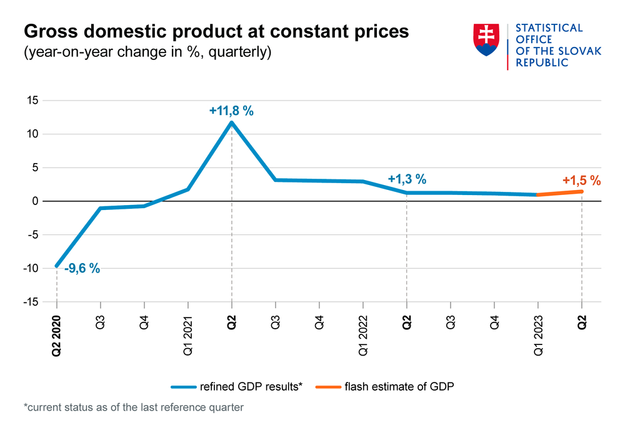The Slovak economy continues to grow. Despite economic problems with high inflation, unpredictable energy prices and high interest rates, Slovakia has still not been hit by recession, unlike other economies, Michal Lehuta, analyst with VÚB banka said.
Slovak gross domestic product (GDP) increased by 0.4 percent quarter-on-quarter in the second quarter of 2023. It grew 1.5 percent in constant prices year-on-year, according to the Slovak Statistics Office.
“The growth of the Slovak economy in the second quarter was a pleasant surprise,” wrote Ľubomír Koršňák, analyst of UniCredit Bank Czech Republic and Slovakia, in a memo.
Macroeconomic data suggests the economy was mainly driven by domestic carmakers. An easing of ‘bottlenecks’ enabled them to restart production, which persisted in the second quarter, while higher output in the domestic automotive sector also positively influenced Slovakia’s trade balance.
However, the negative effects of record inflation were increasingly felt in household consumption, Koršňák noted.
“It hindered, rather than supported, growth,” said Koršňák.
Economic growth in the previous year was driven by household consumption thanks to pandemic savings, Marián Kočiš, an analyst at Slovenská Sporiteľna bank, said.
“From beginning of this year, however, the situation has changed,” Kočiš said in a memo.
Household consumption is under pressure due to weak retail sales, which were negative throughout the second quarter. Kočiš expects household spending will remain under pressure due to the low savings rate, which has reached a minimum level, coupled with negative real income.
“Households will continue to carefully consider each purchase in areas of goods that are not essential for life,” said Kočiš, adding that on the other hand, spending on services could make the total consumption of households improve, such as services related to recreation.
The outlook for the external environment in the second half of the year is, however, increasingly more worrying, noted Koršňák.
“Reasons for concern are mainly weak figures for the German economy, which has long been a key trade partner of Slovak industry,” wrote Koršňák, adding that the mood in the Slovak and European economy is deteriorating. The source of this worsening mood is currently industry, but scepticism is increasingly spreading to the service sector, he said.
The German economy shrank 0.2 percent year-on-year in the second quarter of 2023, following a downwardly revised 0.2 percent drop in the previous quarter, according to preliminary estimates from the Federal Statistical Office.
Nevertheless, Kočiš said a recession was highly unlikely given expected fiscal stimulus of €5 billion in EU funds (around 5 percent of GDP). SLSP is forecasting economic growth for 2023 of around 1.5 percent year-on-year, a moderate decline from 1.7 percent growth in 2022.
UniCredit expects GDP growth to accelerate towards 2 percent next year.
“However, the outcome of the parliamentary election might have a significant impact on GDP growth next year, determining the extent and manner of a necessary consolidation of public finances,” wrote Krošlák.


 Slovak gross domestic product (GDP) increased by 0.4 percent quarter-on-quarter in the second quarter of 2023. (source: TASR)
Slovak gross domestic product (GDP) increased by 0.4 percent quarter-on-quarter in the second quarter of 2023. (source: TASR)
 Flash estinate of GDP for the second quarter of 2023 (source: The Statistics Office)
Flash estinate of GDP for the second quarter of 2023 (source: The Statistics Office)